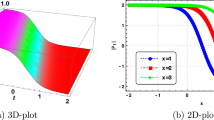Abstract
We study the structure of chaos in a simple Hamiltonian system that does no have an escape energy. This system has 5 main periodic orbits that are represented on the surface of section\((y,\dot y)\) by the points (1)O(0,0), (2)C 1,C 2(±y c, 0), (3)B 1,B 2(O,±1) and (4) the boundary\(y^2 + \dot y^2 = 1\). The periodic orbits (1) and (4) have infinite transitions from stability (S) to instability (U) and vice-versa; the transition values of ε are given by simple approximate formulae. At every transitionS →U a set of 4 asymptotic curves is formed atO. For larger ε the size and the oscillations of these curves grow until they destroy the closed invariant curves that surroundO, and they intersect the asymptotic curves of the orbitsC 1,C 2 at infinite heteroclinic points. At every transitionU →S these asymptotic curves are duplicated and they start at two unstable invariant points bifurcating fromO. At the transition itself the asymptotic curves fromO are tangent to each other. The areas of the lobes fromO increase with ε; these lobes increase even afterO becomes stable again. The asymptotic curves of the unstable periodic orbits follow certain rules. Whenever there are heteroclinic points the asymptotic curves of one unstable orbit approach the asymptotic curves of another unstable orbit in a definite way. Finally we study the tangencies and the spirals formed by the asymptotic curves of the orbitsB 1,B 2. We find indications that the number of spiral rotations tends to infinity as ε → ∞. Therefore new tangencies between the asymptotic curves appear for arbitrarily large ε. As a consequence there are infinite new families of stable periodic orbits that appear for arbitrarily large ε.
Similar content being viewed by others
References
Carnegie, A. and Percival, I.C.: 1984,J. Phys. A17, 801.
Contopoulos, G.: 1990,Astron. Astrophys. 231, 41.
Contopoulos, G. and Polymilis, C.: 1993,Phys. Rev. E 47, 1546.
Dahlqvist, P. and Russberg, G.: 1990,Phys. Rev. Lett. 65, 2837.
Hénon, M.: 1965,Ann. Astrophys. 28, 992.
Jung, C. and Scholz, H.J.: 1987,J. Phys. A20, 3607.
Lau, Y.T., Finn, J.M. and Ott, E.: 1991,Phys. Rev. Lett. 66, 978.
MacLachlan, N.W.: 1947,Theory and Applications of Mathieu Functions, Clarendon Press, Oxford.
Newhouse, S.E.: 1977,Am. J. Math. 99, 1061.
Newhouse, S.E.: 1983, in Iooss, G., Helleman, R.H.G. and Stora, R. (eds.),Chaotic Behaviour of Deterministic Systems, North Holland, Amsterdam, 443.
Petit, J.M. and Hénon, M.: 1986,Icarus 66, 536.
Sohos, G., Bountis, T. and Polymilis, H.: 1989,Nuovo Cim. 104B, 339.
Savvidy, G.K.: 1983,Phys. Lett. 130B, 303.
Author information
Authors and Affiliations
Rights and permissions
About this article
Cite this article
Contopoulos, G., Papadaki, H. & Polymilis, C. The structure of chaos in a potential without escapes. Celestial Mech Dyn Astr 60, 249–271 (1994). https://doi.org/10.1007/BF00693324
Received:
Accepted:
Issue Date:
DOI: https://doi.org/10.1007/BF00693324




